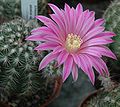Description
Echinocereus adustus typically grows as a solitary cactus. [2] Its shoots are depressed spherical to short cylindrical, reaching up to 19 cm (7.5 in) long and 5 to 12 cm (2.0 to 4.7 in) in diameter, with fibrous roots. [2] It has 11 to 20 wavy, slightly tuberous ribs. [2] The cactus may have up to nine dark brown to blackish central spines, up to 3.2 cm long, with the top spine being very short and the bottom spines spreading horizontally. [2] It also has 8 to 31 white marginal spines with darker tips, up to 1.8 cm (0.71 in) long, with the radial spines being the longest. [2]
The short, funnel-shaped flowers are pink, appearing well below the shoot tips. [2] They are 3 to 10 cm (1.2 to 3.9 in) long and 4 to 7 cm (1.6 to 2.8 in) in diameter, with white or very light green scars. [2] The egg-shaped fruits are up to 2 cm (0.79 in) long with falling thorns, and when ripe, they are almost dry and split vertically. [2]
This page is based on this
Wikipedia article Text is available under the
CC BY-SA 4.0 license; additional terms may apply.
Images, videos and audio are available under their respective licenses.



